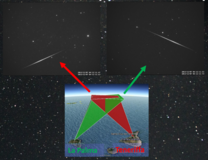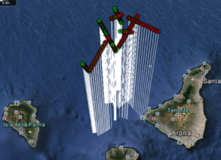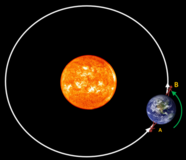Meteors
Meteors
Meteors
If a meteoroid enters the Earth atmosphere, it causes a light phenomenon. This bright trail is called a meteor or shooting star. The light effect is caused mainly by air friction and evaporation of the meteoroid material. Behind the meteoroid an ionized path is formed this way. This path emits light by recombination of the excited electrons of the air atoms. Meteors start at a height of about 110 - 100 km and the meteor trail is typically tens of kilometers long. They have a velocity between 11 and 72 km/s. A meteoroid that did not burn up completely and reaches the Earth surface is called a meteorite.
Meteors that appear isolated are called sporadics. Meteors, which were caused by meteoroids that all come from the same origin, are called a meteor shower. All members of a meteor shower seem to originate from the same position in the sky, the radiant of the shower. The meteor shower is named after the stellar constellation in which its radiant is located. Especially well-known are the Leonids in November (the radiant is located in the constellation Leo) and the Perseids in August (with its radiant in the constellation Perseus). Both meteor showers were caused by the tails of comets.
CILBO - Canary Island Long-Baseline Observatory
In cooperation with the ESA, ESTEC in Noordwijk, the Netherlands.
CILBO was developed to observe meteors. It is composed of two fully automated stations each with an image intensified video camera. The system is installed on the Canary Islands, one on Tenerife and one on La Palma. The cameras are pointing such that they observe the same volume in the atmosphere. This enables the determination of the trajectories and velocities of the meteoroid in that volume. Until 2016 the CILBO system recorded more than 20 000 meteors. This large amount of data enables us to understand connections and seasonal variations.
For example, it was possible to show the well known phenomenon of the Apex contribution with the CILBO data: On average an observer sees 6 – 8 meteors per hour in good weather conditions with the naked eye. The number of observable meteors increases in the course of the night. In the early evening the observer is located at the backside of the Earth with respect to its movement around the Sun (A). The meteoroids have to catch up with the Earth. Hence, their velocity relative to Earth’s is slower and they cause fainter meteors. In the early morning hours the observer is located at the front of the Earth (B). The meteoroids move in the opposite direction with respect to the movement of the Earth. As a consequence, the meteoroids are faster when they enter the Earth atmosphere and cause brighter meteors. This phenomenon is called Apex contribution and was observed with good resolution with the CILBO system.
If you are interested in writing a Bachelor’s or Master’s thesis connected to this topic please contact Esther Drolshagen, Theresa Ott, Dr. Gerhard Drolshagen, Prof. Dr. Björn Poppe, or our external partner: Dr. Detlef Koschny (ESA).
FRIPON
The university of Oldenburg also has a cooperation with FRIPON, the french Fireball Recovery and InterPlanetary Observation Network. FRIPON consists (Dezember 2017) of more than 110 cameras, covering most of the sky over France.
One FRIPON camera is placed on the roof of the University at the Campus Wechloy. Further cameras are planned to be installed in the surrounding area, thus including the north of Germany into the network. Moreover, a joint project is the scientific analysis of the fireball data collected with FRIPON.




